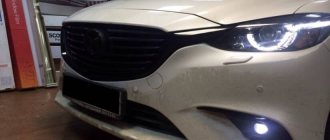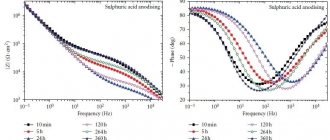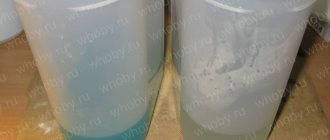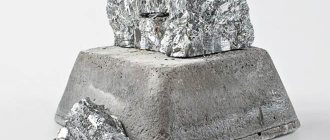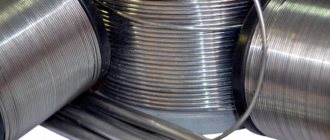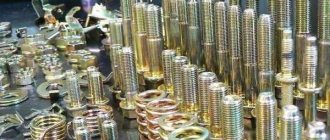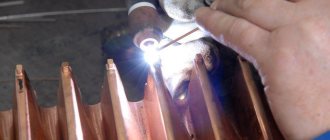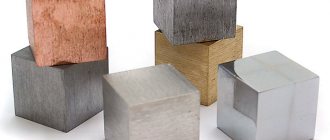What is tinned copper? Let's start with the fact that currently this metal is widely used in various industries. Among the distinctive features of wire, which explain the demand for it, one can note its resistance to external influences: precipitation, temperature changes.
Copper wire also compares favorably with other metals with its high thermal and electrical conductivity.
Options
The main feature that distinguishes the two types of wire is their attitude to deformation. The diameter of tinned copper and aluminum are different. Wire with a diameter that ranges from 0.02 to 9.42 millimeters is in high demand.
To produce this copper, the wire is taken on a spool and subjected to galvanic tinning. Then it is passed through a bath designed for tinning copper wire, where molten tin is located.
To prevent it from reacting with oxygen in the oxidation reaction, the surface of the tin bath is treated with substances that do not allow air to pass through. Charcoal is perfect for these purposes.
Tinned wire or untinned
Cable wholesale from warehouse
- home
- News
- Catalog
- Delivery
- Cooperation
- About company
- Contacts
- home
- News
- Catalog
- Delivery
- Cooperation
- About company
- Contacts
Mail for applications
- Send a request
- home
- News
- Catalog
- Delivery
- Cooperation
- About company
- Contacts
- home
- ||
- Articles
- ||
- Tinned cable
What are the features of tinning a soldering iron tip?
The main thing in tinning is coating the copper base with a thin layer of tin, which can protect the material from corrosion and the effects of natural anomalies. This process has characteristic properties.
- First of all, prepare the working surface: use the latest soldering iron, sharpen the tip of the device for further work.
- The tip is sharpened with a soldering iron or machine at an angle of up to four hundred degrees.
- If you need to work with small parts, the soldering iron should have a cone shape.
Tinned cable
Tinned copper is copper coated with a thin layer of tin or a tin-based alloy. In radio engineering, this is done to connect copper parts to each other in order to give the joint strength, reduce ohmic resistance, and counteract copper oxidation processes.
The production of tinned copper wire in industrial conditions is carried out using the galvanic method - the wire is immersed in a bath of molten metal, as a result of which its surface is evenly covered with a layer with a thickness of 1 to 20 microns - depending on the current strength involved in the electrochemical process. In order to achieve perfect uniformity of coating thickness, the wire is then passed through a drawing mechanism equipped with diamond discs.
The wire tinning process can be seen in the video below.
Technology
Over time, the copper surface is able to react with oxygen to form its oxides. To prevent this, the material is coated with a layer of tin. To do this at home you need to use solder, a soldering iron and flux.
To carry out high-quality work, you need to warm up the soldering iron well. Then the copper product is coated with a substance made of resinous substances and heated over the entire area. Tin is distributed over the entire section of the wire, which is first treated with rosin.
Due to intense physical activity, the conductors in the headphones that use low voltage current are broken. They have a small diameter, and because of this, when tinning they use other technologies: first, the broken wires are soldered off, then new ones are soldered. In order to provide insulation, the wires are coated with varnish, which is removed. The tin layer makes subsequent soldering easier.
Tinning
- applying a thin layer of molten tin to the surface of metal (primarily steel and iron) products. Tinning is done to protect the metal from corrosion or to prepare for soldering (the tinned surface is better wetted with solder).
At low temperatures, tinned products are susceptible to tin plague and require re-tinning.
Step-by-step instruction
The simplest and most common way to tin a surface is to process it with a soldering iron, so we will consider this method in detail. Once you have prepared everything you need to tin the wires, follow these steps:
- Determine the length of the area to be processed - it is recommended to tin the sections in the range from 10 to 50mm. If there are no specific requirements for this parameter, then a distance of 10 - 20 mm will be optimal.
- Remove the insulating coating from the length of wire, in this example a sharp knife is used, but you can use other tools.
Rice. 3: Remove insulation
Be careful when removing layers of dielectric so as not to damage the core, which is especially important for multi-core wires, as this will significantly reduce their cross-section.
- If there is varnish insulation on the wires, it should also be removed until a metallic sheen appears.
Rice. 4: Clean the varnish from the wire
You can use the same knife for this, but this is not always convenient. Since thin conductors are easier to process with sandpaper, a file or chemical reagents. Stranded wire grades must be fluffed in order to process them from all sides.
- Before tinning, it is necessary to clean the tip from residual solder, carbon deposits, and pieces of metal. This can be done using sandpaper or a file; especially large deposits can be removed with a knife.
Rice. 5: Clean the soldering iron tip - Turn on the soldering iron and wait until it warms up completely. If you are a novice radio amateur and cannot yet anticipate the sufficiency of heating in terms of time or external signs, touch the tin with the tip of the soldering iron, the solder should instantly melt - this means that you can start soldering with a soldering iron.
Rice. 6. Test the sufficiency of heating the soldering iron - Heat the stripped wires with a soldering iron and place them in rosin.
Rice. 7: dip the wire in rosin
Wait for the flux to melt and carefully rotate the wire under the tip. Achieve even distribution of rosin over the surface. If you do not tin with rosin, but use some special fluxes, the technology for their use may differ.
- Heat the solder and apply it to the tip of the wire; if there is enough flux and it is evenly distributed over all surfaces, the tin will quickly cover the area you need.
Rice. 8: Heat and draw solder
Turn the wire at the soldering iron tip so that the tin layer covers the entire electrical contact area.
- After tinning, carefully inspect the solder layer; it should have a smooth, even surface of a light color. If your result is different (there are lumps, uneven distribution or dark spots), then it is better to repeat the procedure and strip the wires again.
Due to the wide variety of copper and aluminum wires and types of electrical connections, such elements need to be tinned in different ways, following a certain technology. Such knowledge is available to experienced radio amateurs, but we will consider the most common ones.
What is tinned copper?
Copper becomes tinned after it is treated with tin, another metal or its alloy. In most cases, copper is coated with tin, since this element is inexpensive and at the same time gives the copper product new properties: strength, resistance to damage, and others. As a result, the material becomes more durable, its service life increases, and it is also resistant to external negative phenomena such as corrosion. The tin coating protects the material from chemical aggression and mechanical damage as a result of impacts or falls. Tinned copper is widely used in the construction and repair industry, in the production of drainage systems and in the production of electrical equipment. Our company is engaged in receiving tinned copper. We can also sell copper at a high price.
Advantages of tinned copper wire
Tinning the surface of copper with tin protects it from the destructive effects of atmospheric oxygen, increases tensile strength and resistance to fracture during repeated bending, and simplifies the soldering process. Poluda - the so-called tin film - also protects copper from the harmful effects of sulfur, which is part of the rubber and plastic from which the wire insulation is made. As a result of all this, the service life of the wire increases.
To summarize, cables with tinned copper conductors:
- stronger
- more durable
- more flexible
- easier to install
The main consumer of tinned copper wires is the electronics and electrical industry.
Area of use of tinned copper and its markings
Due to such beneficial properties as strength and durability, tinned copper has a wide range of applications and is used in the following areas:
- electrical engineering;
- industry;
- construction.
Tin plating gives the copper product strength and a high level of protection from negative environmental influences, which together allows the tensile load to be increased to the maximum.
In the construction industry, tinned copper is often used in the process of finishing the front walls of buildings and roofs, when drainage systems are installed. Due to its resistance to precipitation and sudden temperature changes, such a non-ferrous alloy can be used outdoors without the risk that it will not last long. If we talk about the aesthetic component, tinned copper has a calm silvery tint that attracts and does not strain the eye.
Delivery of scrap tinned copper
We accept scrap tinned copper. Our non-ferrous metal collection centers are located throughout Moscow and the region. Because tinned copper is plated, when calculating the weight and price of scrap, a specific percentage is subtracted from the total weight, which is the weight of the tin or other material used for the coating. The cost of scrap is also influenced by the following factors:
- The absence of impurities of other metals that are not provided for according to the rules for the manufacture of tinned copper.
- The absence of non-toxic additives in the batch, which include: paper, plastic, garbage, and so on.
- The radiation background of the scrap being handed over is not exceeded.
- Lack of small-sized wire with or without firing.
In addition to the above, the cost of scrap directly depends on the volume of the batch. The greater the mass of scrap being delivered, the greater the cost per kilogram.
It is worth noting that there are fewer requirements for mix copper scrap, which is a mixture of copper waste. You can also hand over the copper mix to us.
Stages
In order to understand what tinned copper means, let’s take a closer look at the main stages of the ongoing process. First, the copper wire, which is mounted on a special feed mechanism, is cleaned. The essence of the process is passing through special wiping brushes moistened with a solution of zinc chloride (this salt is obtained by reacting granulated zinc with hydrochloric acid).
Next, the wire is lowered into a tin bath, where molten tin is located, resulting in tinned copper. A photo of the finished product demonstrates the uniformity of the applied layer.
It is important at this stage to prevent the appearance of “sagging” on the wire, as they lead to rejection of the batch due to deviations from the declared diameter.
At the next stage of creating tinned wire, the material is passed through rubber brushes (their diameter should not exceed 0.14 mm) or through a drawing mechanism with diamond discs. A similar procedure is required to give the wire surface perfect uniformity.
The material is then cooled by passing through a container of cold water. The cooled wire is re-passed through a drawing mechanism with diamond discs, getting rid of the remaining “sagging”.
The final step is feeding the wire to the receiving mechanism. Here it is fixed to a special reel. Having gone through the entire chain, the wire is absolutely ready for sale or for the subsequent creation of cables of different sections. Before tinned wire is sent to consumers, it must undergo a control procedure. Its essence is to carry out several operations that will prove its compliance with TU 16-505.850-75.
Source
